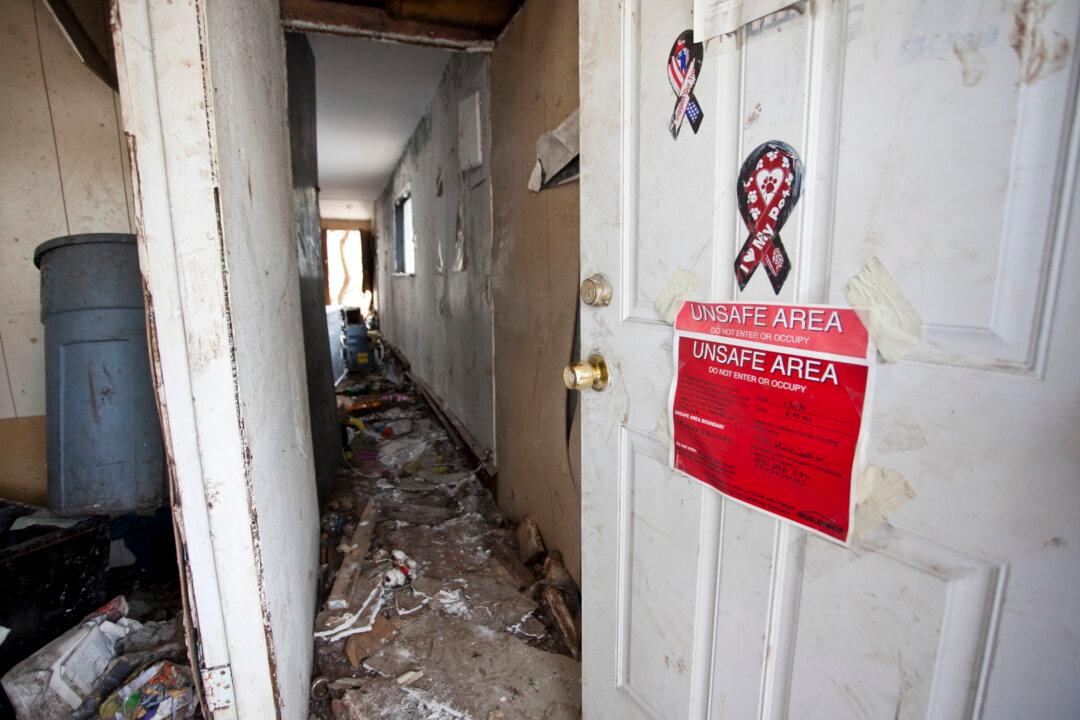NEW YORK—The house at 12 Topping St., has been abandoned since the storm surge from Hurricane Sandy inundated it and swaths of Staten Island’s shorefront communities. Its windows have been boarded up and weeds now claim the front lawn. It is just another ugly relic of a storm that rocked the East Coast and shut down the financial capital of the world seven months ago.
But danger didn’t leave as the waters receded back into Lower New York Bay. Some residents returned to clean up and rebuild, while others conceded to nature and never returned, leaving their waterlogged homes behind amid a community struggling to recover.
As the months went by, mold began to claim these homes inside and out. As most people understand it, mold is harmless. It is found in household dust, and almost any home has some. But the storm surge brought biodiversity. The mold cultures that sprang in its wake came in a kaleidoscope of colors and varieties: purple, green, yellow, and red. And with them came a noxious soup of toxins. Mold cultures are known to exude aflatoxins, ochratoxins, fumonisins, trichothecenes, citrinin, and patulin. Aflatoxins alone are among the most carcinogenic substances known. The other toxins are associated with a variety of adverse health effects.
Fearsome as it is, there are proven ways for dealing with mold. Farid Kaser knows all about it. Kaser co-founded Yellow Boots, a nonprofit, which offers a variety of home repair services to flood victims in Staten Island. Driven by donations and volunteers, Yellow Boots performed mold removal jobs in nearly 250 homes in the aftermath of the hurricane.
To get rid of the mold, Yellow Boots workers have to gut the entire house, stripping sheetrock, insulation, tar paper, screws, nails, and studs, leaving nothing but the bare skeleton of the house. Workers spray everything with a potent mix of Microban and Borax. They then vacuum-seal the entire building, bring in a 175,000 BTU heater, crank up the heat, and set up fans in the back of the house to blow out the moisture as it sweats from the beams, floorboards, and ceilings. The entire job takes three days.
All could be well, but the abandoned houses, teeming with mold, are off-limits. Since they are private property, no work can be done without an owner’s permission. Residents in New Dorp Beach have been eyeing these properties, and some, like Dee McGrath began to keep a register of them. There are 26 in total in New Dorp Beach alone.
The city health department’s stance is that these homes pose no danger. The only way to get into them and clean out the mold would be if they were deemed a threat to public health, but the department would not budge.
When questioned as to the reason for the department’s position, Veronica Lewin, a department spokeswoman, would only say that “mold in an abandoned home does not generally pose a health risk to neighbors.” Lewin would not reveal how decisions on public health threats are made, and would not comment on why the abandoned homes have not been designated a public threat.
Congressman Michael Grimm addressed the locals’ concerns in a letter to Mayor Michael Bloomberg on July 1. Grimm urged Bloomberg to pressure the city’s health department to classify the abandoned homes as a public health threat.
“Whatever the reason, residents are deeply troubled by the threat these neglected structures pose to the safety of the neighborhood, as they stand on their blocks essentially as massive mold incubators and dangerous lures for curious children, vermin, and those looking to engage in illicit behavior,” wrote Grimm.
“While no one wants an individual’s property rights to be unduly violated, we have reached a point where the health and recovery of our constituents in these neighborhoods are being jeopardized by these still-neglected structures,” he wrote.
Grimm held a press conference in an abandoned home and several houses down from 12 Topping St. The owner, Nicole Chati, had hopes for fixing it and paid around $3,000 for a mold job. But when new flood maps were released, her home’s elevation was not up to building codes. Since the house was built in three portions it could not be lifted and put on stilts, so it now sits awaiting demolition. To make matters worse, the mold job she paid for was subpar.
“This is a perfect example of a bad mold job,” Kaser said, pointing out large sheets of tar paper that had not been removed, insulation still intact, and patches of sheetrock still stuck on nails—all traps for moisture and ideal habitats for mold. He pulled back a wide sheet of tar paper revealing outcroppings of dark mold.
Class Action Lawsuit
McGrath fell sick with pneumonia for the first time in her life in the months following Hurricane Sandy. She knows two people in nearby Midland Beach that came down with lung infections.
“The mosquito population is ridiculous in the neighborhood,” McGrath said. “Yesterday we had complaints of raccoons living in some of these houses, as well as other rodents. And the smell, when you pass by these houses you can smell the mold in the air.”
Fed up with the lack of action from the city, the residents are seeking legal help. Several lawyers have been contacted and showed interest in filing a class action suit against the city.
The group has also reached out to Erin Brockovich, an environmental activist famous for her role in the class action suit against Pacific Gas and Electric in a case alleging the contamination of drinking water, which was settled for $333 million in 1996.
“We’re very, very frustrated,” McGrath said.





